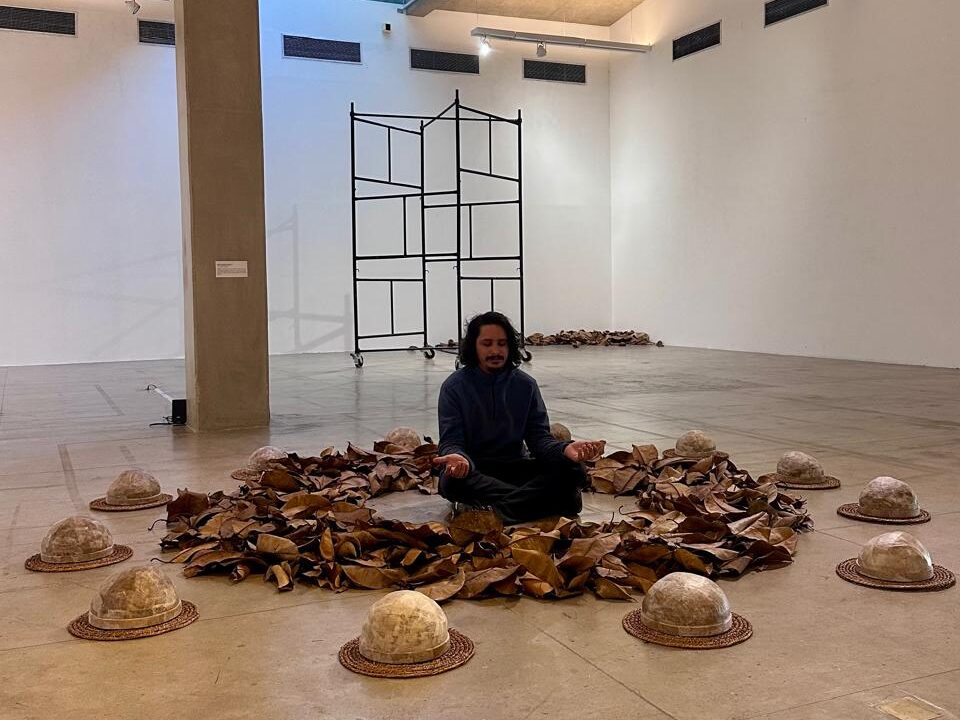The exhibition, curated by Sonia Guggisberg, featured works in video art, photography, performance, and soundscapes that explored, through the body, the contemporary crisis between humans and nature. The exhibition proposed a sensitive mapping of the loss of ecological balance, provoking critical reflections on climate change and environmental vulnerability.
By: Jorge Pimentel
During the month of June 2025, Instituto Juruá, through my work as an intern in Audiovisual Production, was part of the production team of the exhibition Bordas do Corpo (Edges of the Body), held at Espaço das Artes (EdA), the former headquarters of the Museum of Contemporary Art of USP – University of São Paulo. The exhibition was conceived by artist and researcher Sonia Guggisberg, in partnership with the Graduate Program in Visual Arts at the School of Communications and Arts of USP (PPGAV/ECA-USP), and with institutional support from Instituto Juruá.
This experience provided me with intense contact with the behind-the-scenes of a contemporary art exhibition and allowed me to develop skills in cultural production, artistic mediation, and audiovisual and photographic documentation. I also deepened my understanding of themes such as body, territory, and socio-environmental crisis, reflected in the artworks and in the interactions with the public and the artists.
Photo carousel: Photo 1 – Image capture process for the documentary; Photo 2 – Guitar circle and people handling the instruments featured in the exhibition by artist Eliberto Barroncas; Photo 3 – Image showing part of the Bordas do Corpo exhibition. Author: Sonia Guggisberg.
Art as a tool for socio-environmental engagement
I believe that the artistic practices experienced during the exhibition have great relevance for initiatives such as those developed by Instituto Juruá. By promoting listening, expression, and mobilization, art shows itself as a powerful ally in processes of environmental education, valorization of local knowledge, and strengthening of the dialogue between science, culture and amazon communities. This experience reinforced my conviction about the transformative role of art in contexts of socio-environmental work.
Photo: Jorge Pimentel in the performative photographic exhibition. Credit: Sonia Guggisberg.
The arts have a fundamental role in people’s sensibilization regarding climate change and the relation with nature. By translating complex issues into sensitive and symbolic experiences, art brings us emotionally closer to themes that often seem distant or abstract. During the Bordas do Corpo exhibition, I was able to notice how performances, videos, and installations provoked profound reflections in the public about the relation between body, territory, and nature. Through artistic language, it is possible to access affective dimensions, stimulate critical thinking, and create spaces of empathy and listening, contributing, in a powerful way, to consciousness and engagement before the environmental urgencies of our time.
The artistic activities developed in the Bordas do Corpo exhibition directly dialogue with the principles and actions of Instituto Juruá, especially regarding the valorization of local knowledge, the promotion of sensitive narratives about amazonian territories, and community mobilization around socio-environmental conservation. The experience with performance workshops, cultural mediation, and exhibition production allowed me to understand how art can be a powerful tool for listening, expression, and collective construction, strengthening processes of environmental education, territorial communication, and the engagement of riverine populations.

Jorge Pimentel energetically interacting with the Bordas do Corpo exhibition and the performative instruments. Credit: Sonia Guggisberg.
In alignment with researcher Guggisberg and the IJ board, we see as a future possibility: territorial communication and the engagement of riverine populations through artistic processes and the valorization of cultural knowledge and practices. These practices contribute to expanding the channels of dialogue between science, art, and communities, enhancing the creative participatory strategies that are already part of Instituto Juruá’s work.